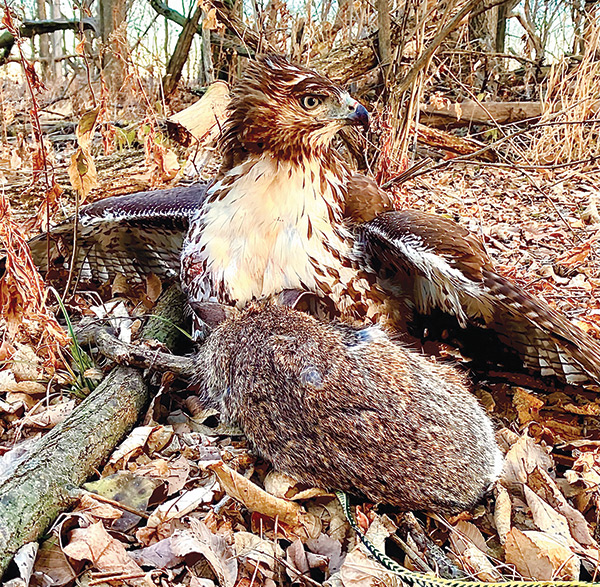 Hunting: Exploring the Art of Falconry
Hunting: Exploring the Art of Falconry
By Kevin Shepherd
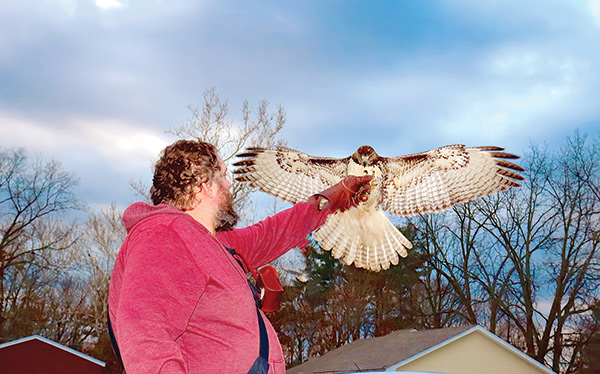
Established falconers will tell you that you’ll never forget your first bird’s first catch. It’s the culmination of everything the falconer has accomplished to get to that point, the study and practice of an ancient art, with a bit of luck. It’s the first time a new falconer and a truly wild bird cement a partnership that has existed between man and raptors for millennia. I recently joined the ranks of falconers and I’d like to share the story of Loretta, my first hawk.
Falconry Basics
Falconry is the art and practice of using a trained bird of prey rather than a shotgun, rifle or bow to harvest game. Falconers usually target small game – rabbits, squirrels, upland birds and waterfowl. It’s also the most regulated form of hunting in the United States.
To become a falconer, one must pass the state falconry exam (specific to each state), build a mews (the facility the raptor will live in), have that mews inspected and approved by a conservation officer, and find an experienced falconer as a sponsor for a two-year apprenticeship. My sponsor was Mark Dyson.
In Iowa, where I live, apprentices are only allowed to fly wild-caught, “passage” red-tailed hawks. These are juvenile birds, on their first migration south. We’re not legally allowed to fly captive bred or hand-raised birds. After months of studying under Mark’s guidance, passing the test, then construction and inspection of the mews, it was time to find and trap a bird.
Catching a Hawk
Because it’s highly illegal for anyone not in possession of a falconry license and a take permit for raptors to even attempt to trap a hawk, a detailed explanation of the technique can’t be provided – at the request of my sponsor. There are several different methods that could be used, but the trap I used was what apprentices normally use to catch redtails in the U.S.
On my first day of trapping, Mark and I coaxed a male hawk down to the trap several times, but he somehow managed slip away. After that, I was on my own. For more than a month, I drove around, setting the trap below several birds. Only one flew down but didn’t commit. She pulled up at the last second, flew to a nearby power pole and ignored me.
On the first cold morning of autumn, I stopped by Mark’s on my way to go hawk trapping. Mark said it should be a good morning because a cold front would make the birds hungrier. How right he was.
With my old Ford pickup pointed northwest, I turned on the radio. A Loretta Lynn tribute was playing, with “Coal Miner’s Daughter” coming through the speakers. I followed dirt roads, searching every power pole and tree for a hunting redtail. About 20 minutes into my journey, I pulled through a four-way intersection.
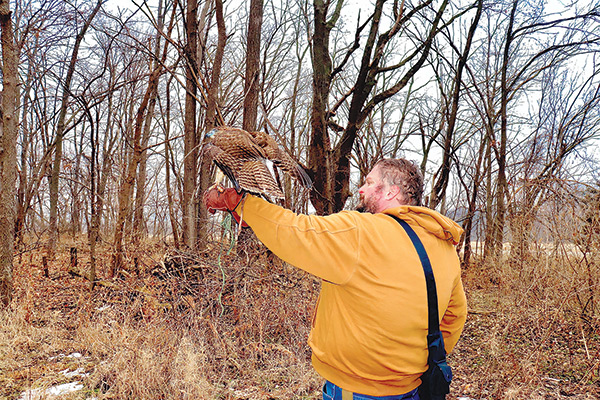
I caught a familiar shape on a power pole out of the corner of my eye and tried to get a better look, but before I could the bird flew to another pole. I turned the truck around, drove ahead, and bumped the bird again. About 75 yards further down the road, I stopped, used my binoculars to check the hawk. A band of brown feathers on the bird’s breast identified it as a juvenile, a legal capture. Pulling as close to the bird as I dared, I set the trap and backed away.
Waiting, I watched the bird through binoculars. It turned its head several times towards the trap. Then, what I’d been waiting for happened: The hawk flew down.
My heart leaped. Would this be my bird?
The bird slammed the trap and used its momentum to try to fly away but came back to ground a few feet away in a cut bean field.
I rushed to the bird as fast as I could. The hawk’s brown tail confirmed that it was a juvenile. Remembering Mark’s advice about how to grasp a trapped hawk, I slipped a falconer’s hood over the bird’s head, wrapped it to prevent injury for the drive back to Mark’s. (The hood is a device used to comfortably cover the bird’s eyes. Hawks are extremely visually oriented. They immediately become calm with their eyes covered.)
She was a female redtail and I named her Loretta, to honor the queen of country music, which seemed fitting.
Training Loretta
Our partnership started off well. Loretta was skinny and hungry when I caught her, so she was compelled to eat “off the fist” the first day. Eating off the fist on day one is what every falconer hopes for with a freshly caught passage bird. The bird’s lowering its head, to take food from the falconer’s leather-gloved hand, near its feet, with the falconer so close, takes much trust. The bird is exposing itself to potential danger, many birds fear for their lives near the falconer the first day.
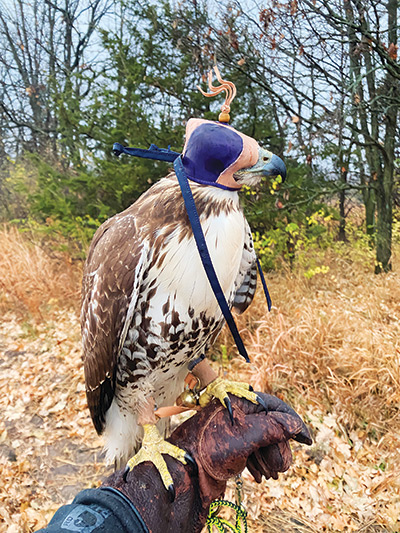
After that, things progressed quickly. There was a little trouble taking the first step from her perch to my glove, but Mark helped, showing me how to start this by letting her begin to eat, then gently lifting the glove so she had to put her foot on the fist. Soon she was flying across the living room to me.
After about two weeks, and many conversations with Mark, we started working on creance flying. The creance is a long leash attached to a bird to get it flying increasingly longer distance to the falconer in a controlled environment.
oretta and I went to a park for her first creance flights. I unhooded her, set her on a post. She only took a minute to take in the sights and orient herself to her surroundings before flying 10 feet for the tidbit of rabbit on my fist. (I planned to hunt Loretta on rabbits, so I fed her rabbit meat throughout training. It was her favorite food.) We repeated this, then moved to 15 feet. She responded immediately, so I tried 25 feet, then 50. She ate the last of her rabbit after a 50-foot flight.
I felt like I was floating on air as Loretta ate from my fist – a feeling much like watching a bird-dog puppy make their first point, or the first time a beagle pup opens in the starting pen. It’s something truly special to have a wild bird respond to your whistle from a distance.
For the next few days, we worked to increase Loretta’s creance distance. Mark wanted us to work up to flying 100 yards with immediate response. We reached this goal in just a few weeks. Loretta tried to follow me quite a few times as I walked away. After I sat her on her perch and walked away for the next flight, she’d only wait a few seconds before flying after me. When she realized I wasn’t going to turn around and offer her the fist, she’d land on the ground and wait. She’d be sitting there between me and the perch.
One evening Mark and I received a call to help a kestrel caught inside an event center. After safely removing the kestrel, I flew Loretta on the creance with Daisy, my English setter, running loose in the field, so Loretta could see the dog while flying. I wanted to fly Loretta over beagles, but I didn’t own a beagle, so Daisy was a substitute.
Mark supervised and gave tips. Loretta was herself and did great for most of the session, but near the end she flew up onto a shed and didn’t want to come down. I tossed the lure – a piece of leather with a large chunk of meat tied to it that the bird learns represents a good meal – but she just watched me. It wasn’t until I got right beneath her and held up a big tidbit on the glove that she decided it was worth coming down for. I got her hooded, back in the truck. Falconry is not for the faint of heart.
A week later, Loretta’s moment of truth—her first free flight—arrived. I drove to nearby public land with the goal of successfully getting her back to my glove. I also wanted to fly her where we might find a rabbit.
My heartbeat echoed in my ears attaching the telemetry transmitter to Loretta’s leg that dreary, foggy afternoon. Falconry telemetry works like the radio telemetry houndsmen use: The bird wears a transmitter that emits a certain frequency. The falconer’s receiver is tuned to this frequency, so if the bird goes out of sight, the falconer can scan a 360-degree circle with the receiver and find the bird.
With Loretta on my glove, I walked her out toward the tree line, took a deep breath and said a small prayer as I unclipped her jesses – leather straps fastened around the bird’s legs, that hold the leash to the bird – and removed her hood.
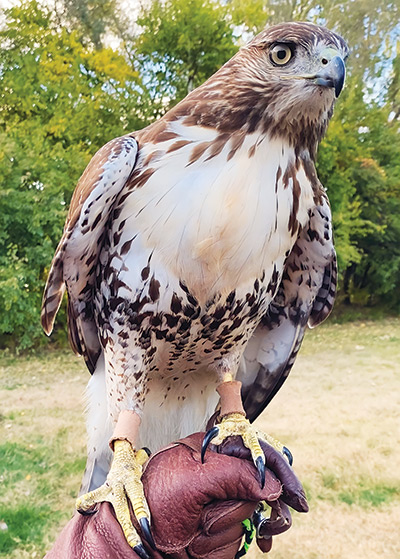
She looked at me, then looked around. I set her on a low tree branch and stepped back. We looked at each other again, then I whistled and lifted my fist. Her response was immediate, she left the tree and came down to my fist.
My spirits soared. It was a miraculous feeling to have an unleashed raptor come eagerly to my fist.
Redtails are usually flown in a “following on” hunting style, meaning the bird follows the falconer from the treetops. This goes right along with the redtail’s natural hunting style of diving on prey. I put Loretta back up on a branch and started walking along the tree line. She jumped up to the next branch and flew to a tree right above my head. I called her down for a tidbit to reward her for following. After a few more recalls and followings, I walked into an adjacent crop field and tossed the lure. Loretta shot out of the tree, hit the lure in midair and was returned to my glove with a big meal reward. I was overjoyed with her progress.
Success!
The next day we were at it again.
Redtails are built to catch squirrels and rabbits. Some falconers hunt birds with them, but their wheelhouse is furred game. I’m a rabbit hunter, and since Iowa’s only squirrels are fox squirrels with big teeth that can easily injure a redtail’s foot, I was concentrating on cottontails.
I’d run beagles with a friend in the area, so I knew we might encounter rabbits. Little did I know how much the hounds do to get a rabbit moving. With Loretta following, I spent two hours beating brush, occasionally calling her to my fist, but we never saw a single rabbit.
The following day, we tried again. Loretta followed me, as I pushed through the brush. Suddenly, I heard the bells attached to Loretta’s anklets, and quickly turned to watch her fly, hovering about 50 feet above me, facing into the wind. Her sharp beak and clear eyes were laser-focused on a spot in the brush below. Sprinting to where she was focused—a fallen tree—I kicked it as hard as I could, hoping to flush game.
A sandy colored blur emerged from the branches. Loretta dropped her left wing and rolled out of the sky like a dive bomber. I was already running toward her as she crashed into the tangle of roots and branches.
She had a rabbit in her talons!
I was overcome with awe, disbelief, pride and gratitude watching Loretta mantling, wings spread, atop a root, talons clutching the rabbit under her. Coming to my senses, I helped untangle her, clipped her leash back on and sat with her as she began to eat. I snapped a picture and sent it to my wife, Mark and another falconer friend. Their excitement flowed through their text responses.
Loretta ate for about 15 minutes before slowing down.
Typically, falconers feed their birds well-rationed meals to keep them at a healthy weight, but also small meals to make sure they’re hungry and ready to hunt. I let Loretta gorge on her rabbit, so she’d learn that when she caught game, she got to eat a lot.
When she slowed her pace, I traded her a tidbit for the rabbit, got her hooded and on my fist for the walk back to the truck. Half the remaining rabbit was saved for Loretta’s meals, half for the frying pan.
Replaying the events as I returned Loretta to her travel box, I felt a real sense of accomplishment and pride. I also felt honored that a wild creature chose to work with me, enhancing both our lives. We’d shared a remarkable journey.
Since that day, Loretta and I have caught more game, but nothing tops that first rabbit, when I became a true falconer. Our partnership awoke something ingrained, a thing almost as old as human history, in me. The old falconers were right. Witnessing the natural dance of predator and prey was now in my blood.
